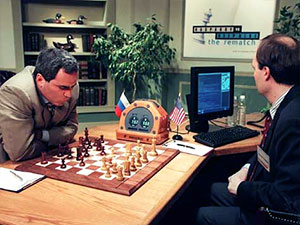The year was 1997. Garry Kasparov, one of the most dominant champions in history, including a record fifteen consecutive tournament wins, was playing Deep Blue for the second time. In 1996, he had played IBM's supercomputer and beat it comfortably in a high profile match, and the blue chip company made its goal to defeat him, investing tens of millions of dollars in exclusive research and development, dedicated hardware that had no other purpose than to play chess, and top grandmasters as consultants.
The match was being followed all over the world, with media coverage befitting the football World Cup, and rather innovatively at the time: on the internet in real time. After five of the six games, the score was tied up 2.5-2.5, but already there were changes in the air. A number of the moves played by the chess supercomputer were completely different from the usual brute force play that players had come to associate with computers, reminiscent of genuine grandmaster decisions. After the anti-climactic game six that ended the match in its favor, there wasn't a player alive who did not secretly wish they had their own private Deep Blue to consult. That day has already come.
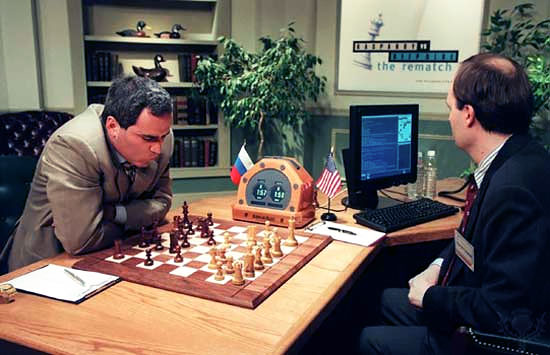
It was literally the clash of the titans as Garry Kasparov faced IBM's monster
It wasn't today, nor even yesterday, honesty compels me to say, and the exact 'when' is up to debate, but there is no question that today, when a user loads up an engine such as Komodo 8 on his desktop, and or even on a modern quad-core smartphone, they are consulting a chess engine that would beat Deep Blue quite handily were they to bump heads today. These aren't idle claims and are easily verifiable even without actually running such a match.
In 2000, a few years after Deep Blue had been irrevocably mothballed, and the talk of a rematch had definitively been put to rest, IBM released the complete computer logs of the games available for any and all to consult. The files were as complete and detailed as one could want, and two versions were published at the IBM website: the unedited digital diarrhea with all the data it produced per move, and a cleaned up version that made the more relevant parts readily legible, such as the depth, nodes (positions) analyzed, evaluation, and main line.
In Mega 2015 we can also find the deep annotations of the games by GM John Nunn, who weighed in with his usual precision and circumspection. We can thus see what a top grandmaster thought of the decisions in the game, added to the evaluations and analysis of Deep Blue itself, and compare them to what a top modern engine thinks of it.
Revisiting some key moves of the games will not only shed light on how the evaluations have held up to time, but the progress that has been made since then.
The Deep Blue logs
IBM has several spaces dedicated to Deep Blue, one of its great successes, some recounting the project and history, and also the replayable games with complete notes. The site does not merely include the complete computer moves and analysis, but also all the live commentary made at the time by Maurice Ashley (who was not a GM yet), IM Mike Valvo and GM Yasser Seirawan among others. Sadly these transcripts only cover the early opening phase since after that the live commentary files are blank.
Link to the Deep Blue logs
Game one
The first game of the 1997 rematch was one that had to remind players of the rout from the previous year when the world champion had dominated the computer with a 4-2 win, and a demonstration of prevailing human superiority. Kasparov played specifically against the machine, taking it out of its book even at the expense of best play, and attempting to keep the game under control throughout. Although his play was not perfect, nor was Deep Blue's, and eventually this cost it the first game.
Position 1

Deep Blue plays 10...h6
Based on the wonderful notes by John Nunn, the first move that he really objects to is 10...h6. This isn't entirely true as he disagrees vehemently with Kasparov's choice of 10.e3, but it is known that Garry adapted his play specifically to Deep Blue, in order to neutralize its opening book, as well as moves that might benefit the computer's tactical prowess.
John Nunn:
"Kasparov's deviation at once earns its reward. Instead of putting the extra tempo to use by developing queenside counterplay, for example by 10...a5, the computer makes a pawn move which is worse than useless, because it weakens the kingisde slightly. In a few moves we will see the importance of this. Now that the extra tempo has been handed back, the balance again slightly favours White and now the computer is on its own."
Deep Blue:
Here is Deep Blue's analysis that led to 10...h6
3(4) 8 T=0
Ph7h6 pg3g4
4(5) 8 T=0
Ph7h6 pg3g4
5(5)[h6](14)[e5](24) 24 T=0
Pe6e5 pe3e4 Bh5f3n
6(5)[e5](14) 14 T=1
Pe6e5 pe3e4 Ph7h6 pg3g4
7(5) #[e5](21)####################################### 21 T=2
Pe6e5 pe3e4 Ph7h6 pg3g4
8(6) #[e5](13)####################################### 13 T=5
Pe6e5 pe3e4 Ph7h6 qd1e2 Rf8e8 pa2a4
9(6)<ch> 's 120'
#[e5](11)#########[h6](19)############################## 19 T=34
Ph7h6 pc2c4 Nd7c5 qd1c2 Bh5g6 nf3e1 Pa7a5 nd2f3
10(6) #[h6](7)####################################### 7 T=102
Ph7h6 pc2c4 Bh5g6 pd3d4 Bg6d3 rf1e1 Bd6b4
11(6) #[h6](4)[TIMEOUT] 4 T=170
Ph7h6 pe3e4 Pd5e4p nd2e4P Nf6e4n pd3e4N Qd8e7 qd1d3 Rf8d8 qd3c3 Pe6e5
---------------------------------------
--> 10. .. h6 <-- 30/98:7
---------------------------------------
A quick commentary should be made to understand the above, as it doesn't exactly follow the typical engine output we see nowadays. The 3-11 preceding the lines are the depth in plies, so yes, Deep Blue was effectively seeing eleven plies deep at this iteration. The moves in brackets [e5] and [h6] are its main choices at each respective iteration, while the number in parentheses after the move [h6](4) represents the evaluation in centipawns, in this case +0.04 for White. Finally the 30/98:7 represents the number of moves and time to reach the time control.
Komodo 8:
Analyzing the position with Komodo 8 for a few minutes on a mid-range quad-core computer shows the engine agrees with Nunn's choice of 10...a5
10...a5 11.c4 a4 12.Qc2 Qe7 13.cxd5 cxd5 14.Rac1 Bg6 15.e4 dxe4 16.dxe4 Rfd8 17.Rfd1 axb3 18.axb3 Ra2 19.Ra1 Rxa1 20.Rxa1 Bb4 21.Nh4 Bh5 22.Nc4 b5 23.Ne5 Nxe5 24.Bxe5 Bd6 25.Bd4
= (-0.21) Depth: 22 00:04:06 1182MN
You'll note also that it produced this at a depth of 22 plies. However, it should be noted that it considers Deep Blue's choice of 10...h6 as perfectly playable with an even assessment.
Position 2
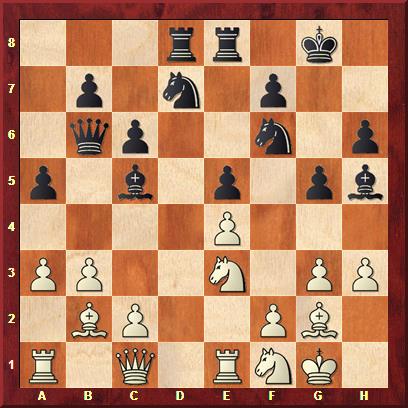
Here Deep Blue played 22...g4?
John Nunn:
"The computer desperately seeks to disturb White's plan. Although this move creates further kingside weaknesses, it enable Black to develop some piece activity. This is the critical phase. Everybody who has played a computer knows the scenario: you get a strategically winning position, the computer makes some desperate tactical lunge, you make a couple of inaccuracies and suddenly the machine is all over you."
Deep Blue:
9(6) #[g4](-11)################################### -11 T=9
Pg5g4 ph3g4P Nf6g4p ne3g4N Bh5g4n nf1e3 Nd7f6 kg1h1
10(6) #[g4](-22)################################### -22 T=53
Pg5g4 ph3g4P Nf6g4p ne3g4N Bh5g4n nf1e3 Nd7f6 bb2c3 Kg8g7 re1f1
11(6) #[g4](-24)######<ch> 'nhf1'
[cont] -24 T=193
Pg5g4 nf1d2 Qb6a7 pb3b4 Bc5b6 ph3h4 Bh5g6 pc2c4 Bb6d4
---------------------------------------
--> 22. .. g4 <-- 18/70:30
---------------------------------------
Komodo 8:
It is rather interesting to see that Deep Blue's main line after 22...g4? is in agreement with Komodo 8. Where they diverge is the evaluation, and by no small margin. Komodo 8 is not nearly as pessimistic about Black's position as the grandmaster suggests, and thinks it is roughly equal, if not slightly better for Black(!) after:
22...Bg6 23.f3 Qc7 24.Kh1 Kh7 25.Rd1 Nf8 26.Rxd8 Rxd8 27.Nc4 Bd4 28.Qe1 Bxb2 29.Nxb2 Ne6
= (-0.14) Depth: 26 00:04:46 1211MN
Whereas, after Deep Blue's move Komodo 8 evaluates:
23.Nd2 gxh3 24.Bxh3 Qa7 25.b4 Bxe3 26.Rxe3 Bg4 27.Bf1 Nh7 28.Nf3 Qb6 29.Qe1 c5
+/= (0.62) Depth: 24 00:02:09 635MN
This difference of 0.76 in the evaluation says it all. Was this an issue of depth, in which Komodo, thanks to nearly two decades of new techniques and optimizations simply out-thinks Deep Blue? It could be, but as a matter of fact Komodo never even considers anything else:
22...Bg6 23.Nd2 Re7 24.Ndc4 Qc7 25.Nf5 Bxf5 26.exf5 b5 27.Nd2 Qa7 28.Re2
= (0.00) Depth: 11 00:00:00 2452kN
The testing revolution
Feng-hsiung Hsu, the chief architect and designer of Deep Blue, stated that it had over 6000 positional parameters that came with zero cost to speed. With so much information at its disposal how did it go so badly astray? The fact is that 6000 parameters mean setting them all precisely correct, and knowing they are also beneficial to the computer's play.
Perhaps the greatest (r)evolutionary change in how this is done came from the author of Rybka, Vasik Rajlich. He introduced the idea of testing at extremely quick games, compiling tens of thousands of game played at 3-4 seconds per game, in order to test a new parameter. This was initially scoffed and dismissed as madness since there was no way the engine could create valid results with such superficial play. Not only was he using this method to validate a new idea, but also to autotune it.
It took time to gain widespread acceptance by the community, but years and years of clobbering the competition by unheard of margins made it impossible to deny, and as the rivals reluctantly tested it for themselves, a new era of chess engine progress came in. Consider that before Rybka in 2005-2006, engines had hit a near standstill evolution of 30-40 Elo per year, if that, but after Rybka, 80-100 Elo was no longer unheard of. In fact, on equal hardware, software alone has progressed over 700 Elo.
Position 3
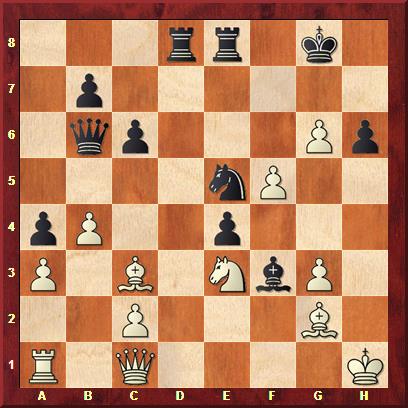
A turning point. The position is already extremely dangerous for Black,
but the super computer has done an excellent job in staying alive. Now
Deep Blue plays 33...Qb5?, a mistake it is unable to recover from.
John Nunn:
"A serious error. DB sees that this will probably lead to the exchange of queens, and has no objection in view of Black's material advantage. However, in the ending White's advanced pawns and general grip on the poisition count for more than the small material plus of rook for bishop and pawn. Instead, Black should have kept the queens on the board."
Deep Blue:
9(6) #[Qb5](-12)##################################### -12 T=29
Qb6b5 bg2f3B Pe4f3b qc1f1 Qb5f1q ra1f1Q Ph6h5 bc3e5N Re8e5b rf1f3P Kg8g7 kh1g2 Kg7f6
10(6) #[Qb5](-6)##################################### -6 T=83
Qb6b5 bg2f3B Pe4f3b qc1f1 Qb5f1q ra1f1Q Ph6h5 bc3e5N Re8e5b rf1f3P Kg8g7 kh1g1 Kg7f6 pg3g4
11(6)[PT=665]?[4 sec (main.c:1391)][TIMEOUT] -6 T=199
Qb6b5
---------------------------------------
--> 33. .. Qb5 <-- 7/44:38
---------------------------------------
Komodo 8:
Komodo quite agrees that Qb5 is a mistake, and gives White +0.69 after it is played. Instead it offers 33...Rd7 as equalizing after
33...Rd7 34.Bxf3 exf3 35.Bxe5 Rxe5 36.Ng4 Qd4 37.Nf6+ Kg7 38.Nh5+ Kg8 39.Nf6+
= (0.00) Depth: 30 00:03:27 1290MN
A move it takes four seconds to find on this computer.
Game two
While game one allowed humans to pat themselves on the back with the quiet assurance that machines were still inferior, in spite of calculating hundreds of millions of positions, if not billions, game two was a wake-up call that things were not so clear cut. The world champion played a Ruy Lopez, attempting to keep the position in a bind and hoping the computer would not know how to use the space for an all-out attack, but over-cautious play on his part and strong moves by the machine shattered that illusion.
Position 4
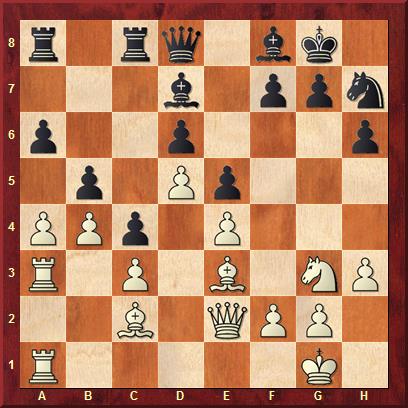
It came as quite a shock to Kasparov to see Deep Blue take the initiative
so aggressively, worthy of a grandmaster, with 26.f4!
John Nunn:
"A stunning move played by a computer. Human beings know very well that opening a second front against a position under pressure can often cause it to collapse completely, but for a computer to find this idea is exceptional. None of the home computer programs I tested found this move at a tournament time-limit."
Deep Blue:
As can be seen by the analysis below, Deep Blue never even considered anything else. Impressive.
8(4) #[f4](30)[f4](30) 30^ T=0
pf2f4 Pe5f4p be3f4P Nh7f6 qe2f2 Pa6a5 pb4a5P
8(6) #[f4](43)######################################### 43 T=2
pf2f4 Pe5f4p be3f4P Nh7f6 qe2f2 Pa6a5 pb4a5P
9(6) #[f4](43)##<ch> 'qd8'
[221 sec (main.c:1847)][cont]####################################### 43 T=33
pf2f4 Pe5f4p be3f4P Nh7f6 qe2f2 Pa6a5 pb4a5P
10(6) #[f4](41)##################[Kh2](42)#######[Bd1](45)############### 45 T=119
bc2d1 Nh7f6 qe2a2 Ra8b8 pa4b5P Pa6b5p bd1f3 Pg7g6
11(6) #[Bd1](43)#[f4](46)[TIMEOUT] 46 T=234
pf2f4 Pe5f4p be3f4P Rc8b8 bf4e3 Bf8e7 pa4b5P Pa6b5p be3a7 Rb8b7
---------------------------------------
--> 26. f4 <-- 14/85:39
---------------------------------------
Komodo 8:
Even though there is no question Deep Blue's move was extremely strong, there was more than one way to progress. Komodo chooses a slightly more positional route, opting instead to triple on the queenside with a penetration of the rook deep into enemy territory.
26.Bd1 Nf6 27.Qa2 Rab8 28.axb5 axb5 29.Ra7 Rc7 30.Ra6
+/- (0.77) Depth: 32 00:04:32 1311MN
Position 5
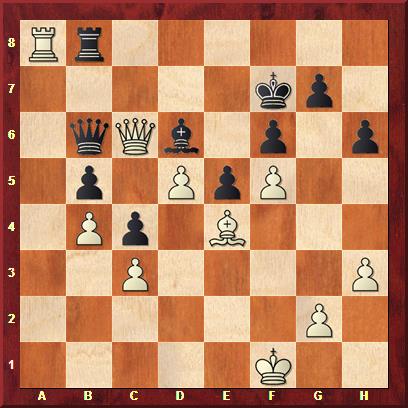
This position is historic as the biggest oversight of the match. There
is no question the situation looks desperate for Black, but Deep Blue
commits a howler that goes unpunished with 45.Ra6??
It took a while for the analysis to be confirmed, since combinations of grandmasters, computer experts, and PC programs of the time were used, but in the end it was confirmed that Deep Blue's move was a terrible blunder that might have allowed Kasparov to save the game. The correct move was 45.Ra1, but not the move played.
Deep Blue:
In this particular case, it is highly possible the computer simply was unable to see deeply enough in spite of the many extensions it used to selectively analyze deeper. Do not be fooled into thinking the depths of 10, 11 or 12 plies displayed below represent the absolute depth it ever saw. Deep Blue had numerous extensions allowing it to see certain lines many many moves deeper.
10(6) #[Ra6](158)########################## 158 T=34
ra8a6 Qb6c6q pd5c6Q Kf7g8 be4d5 Kg8h7 ra6a7 Rb8c8 ra7b7 Ph6h5 rb7b5P Kh7h6 rb5b7 Rc8c7 rb7b8
11(6) #[Ra6](156)########################## 156 T=99
ra8a6 Qb6c6q pd5c6Q Kf7g8 be4d5 Kg8h7 ra6a7 Rb8c8 ra7b7 Ph6h5 rb7b5P Kh7h6 rb5b7 Rc8c7 rb7b8
12(6) #[Ra6](162)[TIMEOUT] 162 T=192
ra8a6 Qb6c6q pd5c6Q Rb8c8 be4d5 Kf7e7 ra6a5 Bd6c7 ra5b5P Ke7d6 bd5f3 Kd6e7 rb5c5 Rc8a8 bf3d5 Ke7d6
---------------------------------------
--> 45. Ra6 <-- 15/75:45
---------------------------------------
Komodo 8:
Komodo 8 does not commit this oversight, and after 45.Ra6 is on the board, quickly revises the evaluation after just second from +2 just a move earlier:
45...Qe3 46.Qxd6 Re8 47.h4 h5 48.Bf3 Qc1+ 49.Kf2 Qd2+ 50.Be2 Qf4+ 51.Kg1 Qe3+
+/= (0.40) Depth: 18 00:00:04 30068kN
Needless to say, 45...Qe3 would have allowed the World Champion to save the game.
To be continued in part two
Komodo Chess 8 includes:
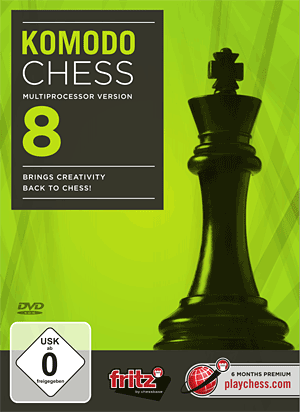
- The Komodo 8 engine, which can support up to 64 processor cores and 16 GB of hash memory
- The new Deep Fritz 64-bit program interface (+ 32 bit program interface)
- Online access to the world’s largest analysis database “Let’s Check”, with over 200 million extensively analyzed positions (free access to “Let’s Check” until December 31, 2016)
- Access to ChessBase engine cloud
- Premium membership to Playchess.com for six months
- Database with over 1.5 million games
System requirements
Minimum: Pentium III 1 GHz, 2 GB RAM, Windows Vista, XP (Service Pack 3), 7/8, DirectX9, 256 MB graphics card, DVD-ROM drive, Windows Media Player 9 and Internet access for program activation, access to Playchess.com, Let’s Check and program updates.
Recommended: PC Intel i7 (Quadcore), 4 GB RAM, Windows 8.1, DirectX10, 512 MB graphics card, 100% DirectX10-compatible sound card, Windows Media Player 11, DVD-ROM drive and Internet access for program activation, access to Playchess.com, Let's Check and program updates.
Price: €79.90 (€67.14 without VAT for customers outside the EU; $86.62 without VAT). Languages: English, German. ISBN: 978-3-86681-442-4; EAN: 9783866814424. Delivery: Download, Post
Order Komodo Chess 8 in the ChessBase shop now!
